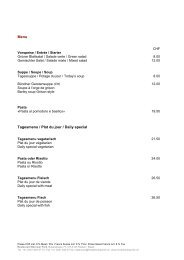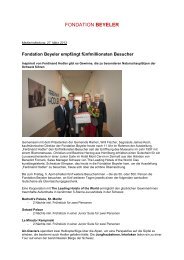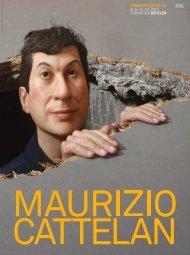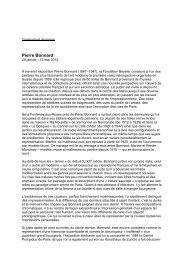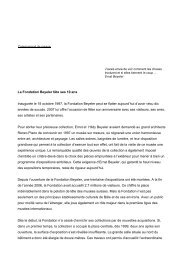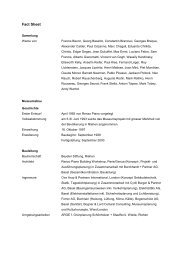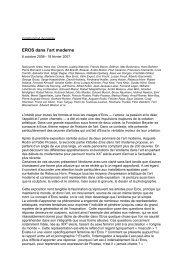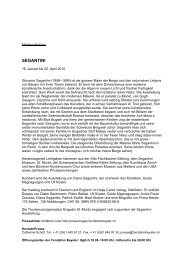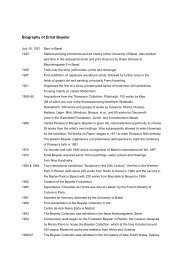"Edgar Degas" PDF - Fondation Beyeler
"Edgar Degas" PDF - Fondation Beyeler
"Edgar Degas" PDF - Fondation Beyeler
Create successful ePaper yourself
Turn your PDF publications into a flip-book with our unique Google optimized e-Paper software.
VISITORS GUIDE E<br />
<strong>Edgar</strong><br />
Degas<br />
”<br />
”<br />
The Late Work<br />
FONDATION BEYELER
<strong>Edgar</strong> Degas —The Late Work<br />
Sept. 30, 2012 —Jan. 27, 2013<br />
CAUTION: Do not touch the works of art!<br />
Extremely fragile paintings and sculptures are displayed in<br />
the present exhibition. We kindly request you not to touch<br />
the works of art under any circumstances<br />
This symbol in the exhibition refers to works which are<br />
commented on below. Please note the number and symbol on<br />
the exhibit labels and the corresponding number in the text.<br />
2
TABLE OF CONTENTS<br />
Introduction 4<br />
ROOm 1 6<br />
ROOm 2A 8<br />
ROOm 2B 10<br />
ROOm 3 13<br />
ROOm 4 16<br />
ROOm 5 18<br />
ROOm 6 19<br />
ROOm 7 21<br />
ROOm 8 24<br />
Information 26<br />
Catalogue 27<br />
Room Plan 28<br />
3
INTRODUCTION<br />
<strong>Edgar</strong> Degas—The Late Work<br />
In an artistic career that spanned sixty years <strong>Edgar</strong> Degas<br />
(1834–1917) produced an oeuvre far greater in size and scope<br />
than those of such contemporaries of his as Claude Monet and<br />
Auguste Renoir. Whereas his fellow Impressionists concentrated<br />
almost exclusively on oil painting, Degas also created<br />
thousands of drawings and pastels and experimented with<br />
printing techniques. For a time he even engaged intensively<br />
with photography. And the posthumous Exposition des sculptures<br />
de Degas (1921) established his reputation as one of the<br />
great painter-sculptors of the modern era.<br />
The <strong>Fondation</strong> <strong>Beyeler</strong>’s Degas exhibition is the first ever to be<br />
devoted exclusively to the late work. It explores in detail the<br />
richness of the artist’s achievement in this culminating phase<br />
of his career, beginning in the latter half of the 1880s, with<br />
the first signs of a fundamental change in the style and content<br />
of his work. He began to abandon the delicate, detailed handling<br />
that had been the hallmark of his Impressionist style and<br />
gradually stopped producing “picturesque,” genre-like images<br />
of city life. After the eighth and last Impressionist exhibition,<br />
in 1886, Degas turned his back on the art world and gradually<br />
withdrew from public life. This encouraged a view of him as a<br />
misanthropic recluse, a view still widespread today. Shielded<br />
from the outside world, this unconventional bachelor lived in a<br />
kind of “inner emigration,” existing for and in his art. He depicted<br />
his principal subjects—ballet dancers and female nudes,<br />
jockeys and racehorses, landscapes and portraits—in ever<br />
new variations and combinations. These extensive sequences<br />
of “serial products” embodied an innovative and prophetic<br />
notion of the work of art: each image not only constituted a<br />
self-sufficient (master)work; it also related to the conceptual<br />
parameters of a constant “work in progress.” The exhibition<br />
therefore includes examples of every technique and motif<br />
featured in the artist’s oeuvre, presented according to their<br />
relative importance.<br />
4
Degas apparently created what he once called “orgies of color”<br />
in a trancelike state in which past and present, things he remem-<br />
bered and things he saw in front of him, merged imperceptibly<br />
with each other. In his deliberately chosen isolation he created<br />
one of the most compelling, almost obsessive late oeuvres in<br />
the entire history of European art.<br />
The exhibition has been devised by guest curator Martin<br />
Schwander in collaboration with Michiko Kono, Associate<br />
Curator at the <strong>Fondation</strong> <strong>Beyeler</strong>.<br />
5
ROOm 1<br />
1 • Danseuses au foyer, 1900−05<br />
Dancers in the Foyer<br />
From the early 1870s onwards, Degas concerned himself with<br />
the motif of dancers, depicting the “ballet rats” of the Paris<br />
Opera in a variety of situations. He employed a range of media,<br />
experimented with materials and textures, and, in his late work,<br />
repeatedly returned to earlier subjects, compositions and poses.<br />
Dancers in the Foyer gives a view of the opera practice room.<br />
In the right foreground we see three dancers in shimmering<br />
whitish-blue tutus waiting for their cue, resting and tying their<br />
shoes while their fellow dancers in the background have already<br />
begun to practice their steps.<br />
Degas unfolds a panorama, an extremely daring composition on<br />
an extended horizontal format. The picture plane is divided in<br />
half by a pillar extending from floor to ceiling, abruptly intersecting<br />
the figure of the dancer in the extreme background.<br />
This feature serves to emphasize the large space on the left<br />
side, which is surprisingly empty. This space remains empty of<br />
content as well, for no one is dancing there yet, an amorphous<br />
color area made legible as the floor of the room only by a few<br />
cast shadows. The whole scene is infused with backlighting from<br />
the full-length windows. This blurs the contours of objects and<br />
figures, dissolves details in shimmering masses of color which<br />
seem to emit light in their own right.<br />
6
ROOm 1<br />
2 • Trois danseuses à la classe de danse, 1888−1890<br />
Three Dancers at a Dancing Class<br />
One idiosyncracy of Degas’s ballet pictures is the fact that they<br />
hardly ever represent the moment of dancing itself. Instead,<br />
his observant eye focuses on the dancers’ behavior before and<br />
after the performance—scenes normally never witnessed by<br />
the audience: the girls holding their weary heads, yawning,<br />
their shoulders drooping, hastily tying their ballet shoes,<br />
scratching and prinking. These gestures tell of the opposite<br />
side of the ballet spectacle and its pretty dancers—the<br />
hard training required of the girls, who often come from the<br />
lower social strata and earn their living this way. They appear<br />
exhausted, sometimes bored, and let themselves go—a crass<br />
contrast to the highly disciplined movements dancing on stage<br />
demand.<br />
The arrangement of figures in Three Dancers at a Dancing<br />
Class is found in a similar form in many of Degas’s dance<br />
depictions. Even the dancer standing in the middle ground,<br />
arm resting on her hip and holding a fan, occurs in several<br />
compositions. The rhythmical sequence of individual movements,<br />
from lowered, raised and profile heads, extended or<br />
bent arms and legs, can be read as a choreography of limbs<br />
that has the effect of an alternative dance performance, just<br />
as compelling as the aesthetic of the dance itself.<br />
7
ROOm 2A<br />
3 • Danseuse russe, c. 1895<br />
Russian Dancer<br />
Degas experts have long discussed the precise sequence of the<br />
total of fourteen pastels and five drawings of Russian dancers,<br />
and also the reason for the artist’s interest in this particular<br />
motif. Today most believe that these works emerged around<br />
1900. Whether or not Degas was inspired by performances<br />
of a Russian folk dance group that appeared in 1895 at the<br />
Folies-Bergère, cannot be precisely established. Whatever the<br />
case, this charcoal and pastel drawing represents a highly<br />
unusual version of the artist’s favorite theme, because here,<br />
the figures are actually dancing.<br />
The women in folk costume dance ecstatically, their skirts<br />
and sleeves swirling, arms and legs flying through the air.<br />
The black charcoal drawing establishes the pose of the two<br />
dancers and their movements, and pastels are used to add a<br />
strong color chord of red, blue and greenish-yellow.<br />
The young Henri Matisse was likely fascinated by Degas’s<br />
images of dancing groups in open, well-nigh amorphous<br />
settings. It is very probable that he saw them in the master’s<br />
studio and that they inspired his monumental painting<br />
The Dance, done just less than ten years later (now in the<br />
Museum of Modern Art, New York).<br />
8
ROOm 2A<br />
4 • Trois danseuses (jupes bleues, corsages rouges), c. 1903<br />
Three Dancers (Blue Tutus, Red Bodices)<br />
This pastel from the <strong>Beyeler</strong> Collection shows three dancers<br />
standing in a row in the wings, waiting for their cue to go on<br />
stage, behind the wall of the set. Degas connects the individual<br />
figures by means of a rhythmical sequence of limbs, forming a<br />
chain that extends horizontally along the landscape scene. This<br />
results in a visual interlocking of the dancers’ gestures and<br />
poses into a single movement. The girls have similar faces and<br />
costumes, and their features are not individualized. This leads<br />
to a well-nigh cinematic effect, the impression that this is<br />
a flowing sequence of the motions of one and the same figure,<br />
in which the culmination of one figure’s gestures marks the<br />
beginning of the next figure’s partial motion.<br />
In addition, Degas blends the separate segments of the picture<br />
space. The silhouettes of the dancers in the foreground and the<br />
materials and patterns of their costumes are interwoven with<br />
the painted landscape on the set behind them. The rendering<br />
of the figures seems hardly more realistic than the painted<br />
scene, which in turn is distinguished as a painted rather than<br />
real forest only by the shadow cast by the hand of a girl resting<br />
on it. All of the forms and colors, animate and inanimate<br />
things, lead a life of their own and combine to form a highly<br />
artificial visual world. The present pastel is typical of Degas’s<br />
late compositions with dancers, in which fragments of scenes<br />
often appear to be excerpted set pieces that cut off the picture<br />
space.<br />
9
ROOm 2B<br />
5 • Etude de nu pour une danseuse à la barre, 1895−98<br />
Study of a Nude for a Dancer at the Barre<br />
This work on paper is a preparatory study intended to establish<br />
the motif and pose of a dancer by means of a nude model. The<br />
pastel-tinted charcoal drawing compellingly proves that Degas<br />
was the only painter in the Impressionist circle who throughout<br />
his life based his work on traditional methods of image-making<br />
such as careful preliminary sketching. The female nude has<br />
placed her left leg on the practice barre and lissomly bends<br />
her upper body forwards. Her right hand grasps her ankle in<br />
order to increase the tension. Degas corrected the pose several<br />
times, as seen from the blurred charcoal lines.<br />
Free, gestural vertical and horizontal hatchings in orange and<br />
red pastel suggest wall and floor as points of spatial orientation.<br />
The woman’s facial features are undefined, as is her light-brown,<br />
gathered-up hair. Despite its reduced means, the drawing<br />
reflects an enormous presence and luminosity.<br />
6 • Danseuses à la barre, c. 1900<br />
Dancers at the Barre<br />
The physical exertions of dancers were closely involved with<br />
Degas’s own work on his pictures. Only by continually challenging<br />
himself and searching for new perspectives, poses and<br />
figure arrangements and experimenting with them, was he<br />
able to achieve the perfection that amounts to true mastery.<br />
This included self-discipline and a devotion to art—traits<br />
shared by the hardworking dancers in order to shine on stage<br />
and convey the beauty and grace of the dance to the audience.<br />
Danseuses à la Barre is based on the preparatory study of a<br />
nude just discussed (5 •) and reflects the development of the<br />
visual idea using a fully dressed model. Degas added a further<br />
figure to the composition, who likewise grasps the barre that<br />
runs diagonally along the wall and into the depths of the<br />
picture. This dancer is depicted from the back, turning her<br />
10
ROOm 2B<br />
head into a profile view, as if her pose were a mirror image<br />
of the body and head positions of her fellow dancer on the<br />
right. The girls’ light-blue tutus are cut off at the picture edge,<br />
yet link the two torsos striving in opposite directions into a<br />
harmonious, sweeping curve.<br />
7 • Danseuses, 1900−05<br />
Dancers<br />
The Degas catalogue raisonné lists a total of seven pastels on<br />
the subject of dancers at rest. All of these are dated to 1896<br />
and evince similar dimensions and compositions, although<br />
their color schemes differ. The low bench appears in many<br />
of Degas’s images of dancers, and very likely belonged to the<br />
furnishings of his studio.<br />
The two dancers have seated themselves on a bench behind<br />
the scenes, apparently in order to rest between appearances.<br />
Their poses reflect great weariness. These poses stand in strong<br />
contrast to the intense colors of their costumes and the entire<br />
pictorial space. The bright orange tutus contain hints of<br />
the greenish, shimmering floor, and the dancers’ complexion<br />
is sprinkled with lilac-colored dots of pastel. One has the<br />
impression that their silhouettes dissolve into the scene<br />
painting behind them and merge with the depiction of trees,<br />
branches and foliage to form a nearly abstract whole.<br />
11
ROOm 2B<br />
8 • Deux danseuses au repos, c. 1898<br />
Two Dancers Resting<br />
This is one of a series of Degas’s pastels that exhibit highly<br />
intense colors. As in many of the other work groupings in the<br />
exhibition, in the late 1880s the artist began to repeat in<br />
variation after variation the type of composition and the poses<br />
of the individual figures. By comparison to Danseuses (7 •),<br />
the contours and outlines are more clearly defined here, and<br />
certain passages are distinguished from one another in terms<br />
of material texture. As if submerged in a sea of luminous blue<br />
tulle, the dancers’ torsos shine out of their puffed tutus. The<br />
bare skin of their shoulders and arms shimmers in a porcelain<br />
white before passing to the pale pink of their stockings and<br />
ballet shoes.<br />
9 • Danseuses sur la scène, c. 1889<br />
Dancers on the Stage<br />
More strongly than the previously discussed ballet pictures,<br />
this oil conveys an impression of the stage and painted backdrops<br />
of the Paris Opera. Five dancers in white tutus are visible<br />
in the right foreground, at the edge of the stage near a bench.<br />
Rather than dancing, they wait to be auditioned, rest, grasp<br />
their ankle, stretch, or practice certain poses. Artificial stage<br />
lighting falls on them like a spotlight, picking out the skin of<br />
their bare shoulders and the tulle of the tutus.<br />
Though they concentrate on the practice session, Degas shifts<br />
this to the extreme left background. There we see the blue-clad<br />
figure of the dancing master in front of two schematically<br />
rendered ballet girls. The heads and bodies of the figures in<br />
the foreground are focused entirely on this point, establishing<br />
a diagonal sightline from right to left and into the background.<br />
The composition is augmented by the landscape scene of a<br />
slightly declining, hilly mountain chain and a blue sky which<br />
terminates the picture at the back.<br />
12
ROOm 3<br />
10 • Henri Rouart et son fils Alexis, 1895−98<br />
Henri Rouart and His Son Alexis<br />
This double portrait of Henri Rouart and his eldest son, Alexis,<br />
is one of the great, ambitious visual projects in Degas’s late<br />
oeuvre. Henri Rouart, a mechanical engineer and passionate<br />
collector of contemporary artists such as Millet, Corot, Daumier<br />
and Manet, was a close friend of Degas’s from their schooldays.<br />
The artist spent about three years making studies of the two<br />
figures for his portrait in oils.<br />
It is striking how emotionally detached father and son appear<br />
here. Henri is depicted as a fragile, carelessly shaven elderly<br />
man with reddened eyes, leaning on his walking stick even<br />
when seated, his head turned seemingly absent-mindedly to<br />
the left. Alexis stands in coat and bowler hat to the left and<br />
behind his father, gazing past us out of the picture. Although<br />
Alexis’s upright figure occupies a great deal of space next to<br />
his father’s hunched form, his gaze is insecure, and the way<br />
he removes his gloves appears awkward. It would seem that<br />
Degas, then in his early sixties, was thinking about aging<br />
—physical aging in the form of illness and infirmity, but also<br />
mental aging caused by loneliness and disappointment. At the<br />
same time, Degas’s enormous powers of observation give us<br />
an idea of the intimate, often sensitive relationships between<br />
human beings, which he has visually expressed with great<br />
compassion.<br />
13
ROOm 3<br />
11 • Autoportrait avec La Femme qui pleure<br />
d’Albert Bartholomé, c. 1895<br />
Self-Portrait with Bartholomé’s “La Femme qui pleure”<br />
In the 1890s Degas began to concern himself with the potentials<br />
of photography, and portrayed friends and acquaintances who<br />
sat for him. He also made a series of self-portrait photographs.<br />
For the development and enlargement of the negatives, he<br />
usually relied on his friend Guillaume Charles Tasset. In this<br />
image, Degas poses leaning far back in an armchair. His head<br />
is turned to strict profile, his hand on his chin in the attitude of<br />
a thinker. Visible behind him is a plaster sculpture by his friend,<br />
the sculptor Albert Bartholomé. Both the artist’s head and<br />
the sculpture of a crouching nude are precisely illuminated.<br />
Beginning with the patterned upholstery at the right edge, the<br />
suggestion of a diagonal leads to the left and into the depths.<br />
In addition, the dark room is artfully divided by vertical bands<br />
of light and shadow.<br />
The technical possibilities of photography were still quite limited<br />
in the mid 19th century. Only small-format prints could be made,<br />
whose halftones varied from black to gradations of grey to<br />
white. Instantaneous photography, which emerged between<br />
1868 and 1871, enabled a reduction of the exposure time to<br />
1/50th of a second and the capturing of motion. The disadvantage,<br />
however, was that the earliest instantaneous cameras<br />
required an especially short focus, which frequently led to<br />
distorted perspectives in the image. As photographing was<br />
possible only with an open lens, the motif usually appeared<br />
underexposed or blurred. Perhaps this was the reason Degas<br />
used older cameras with very long exposures times, which<br />
forced the model to sit motionlessly for several minutes.<br />
14
ROOm 3<br />
12 • Danseuse, le bras tendu, taken 1895/96<br />
Dancer, Arm Outstretched<br />
Danseuse ajustant sa bretelle, taken 1895/96<br />
Dancer Adjusting Her Shoulder Strap<br />
When he turned to the new medium of photography in the<br />
1890s, not surprisingly Degas took pictures of dancers as well<br />
as other subjects. A series of photographs taken in his studio<br />
shows the same girl in different poses and from different points<br />
of view, like those that occur in the pastels: She stretches out<br />
her arms or adjusts her shoulder strap, rotating around her<br />
own axis.<br />
Degas experimented with various lighting effects and mani-<br />
pulated the prints of his photos. He must have found the<br />
reversal of the original light-dark values in the negatives<br />
especially intriguing. An amateur photographer, Degas was<br />
especially interested in the graphic potentials of the technique;<br />
in photography, light itself becomes the draftsman. His<br />
experiments are closely related to those done in printmaking,<br />
especially monotype, a process that as a rule permits only a<br />
single impression to be made.<br />
15
ROOm 4<br />
13 • Femme à sa toilette, c. 1894<br />
Woman at Her Toilette<br />
Degas’s pastels of women washing and drying themselves and<br />
combing their hair are among the outstanding achievements<br />
in his oeuvre. The intimate toilette scenes obviously broke with<br />
the tradition of depicting the female nude as an ideal of beauty.<br />
Not the women but the pictures of them were to show their<br />
best side. The sumptuously colored Woman at Her Toilette<br />
depicts a nude woman from the back, seated on a chair and<br />
drying her neck with a towel. At first sight, the countless lines<br />
and patterns of pastel strokes set next to and over each other<br />
seem confusing. These visually weave the separate elements<br />
together and create the effect of a highly condensed space in<br />
which the things depicted are recognizable only on second<br />
glance: for instance, the small, light-colored dog in the lower<br />
right corner, which we might mistake for a towel or article of<br />
clothing.<br />
14 • La Coiffure, 1886−1890<br />
Woman Combing Her Hair<br />
Most of Degas’s pastels are based on a charcoal drawing, in this<br />
case providing an exciting contrast to the colors. The complex<br />
pose, with crossed legs, slightly rotated torso, bent head, and<br />
raised, angled arms is treated with great realism. The colorful<br />
high point of the composition is formed by the woman’s<br />
carmine-red slippers—an indication of the intimate boudoir<br />
atmosphere.<br />
16
ROOm 4<br />
15 • Femme s’essuyant les cheveux, 1888−1890<br />
Woman Drying Her Hair<br />
Views of nude female figures after the bath form one of the most<br />
thoroughly pursued themes in Degas’s late work. He studied them<br />
in oil paintings, pastels and sculptures. The present unusually<br />
large-format charcoal drawing shows a woman sitting on a<br />
low upholstered seat. Turned away from us in a three-quarter<br />
back view, she bends forward to dry her wet hair with a towel,<br />
resting her right arm on her hip.<br />
This study formed the basis for a whole series of further pictures,<br />
which show the same motif in oils or pastels. The fact that Degas’s<br />
repeated compositions are nevertheless freshly fascinating<br />
lies in the artist’s unique handling of diverse materials, and<br />
his masterly employment of colors and illumination to evoke<br />
volumes on the plane. In 1886, Degas wrote to his friend<br />
Bartholomé, “… you must rework the same subject ten, one<br />
hundred times. Nothing in art should resemble an accident,<br />
not even movement.”<br />
17
ROOm 5<br />
16 • Femme à sa toilette, c. 1892<br />
Woman at Her Toilette<br />
Here the woman stands bent over a washbasin, washing her<br />
left armpit with a sponge. The viewer has the role of a voyeur of<br />
this intimate situation who observes the anonymous woman<br />
from a safe hiding place. This was much the way Degas’s<br />
contemporaries felt when, at the eighth and last of the Impres-<br />
sionist exhibitions, he showed several scenes of women at<br />
their toilette.<br />
The artist confirmed this impression when he explained to<br />
the author George Moore, “In the past, the nude has always<br />
been represented in poses that presuppose an audience,<br />
but my women are simple creatures. I show them without<br />
coquettishness, like animals that are cleaning themselves […]<br />
It is as if you were looking through the keyhole.”<br />
18
ROOm 6<br />
17 • Chevaux de courses, 1884<br />
Jockeys on Horseback<br />
The motif of horses suffuses Degas’s oeuvre in diverse media. It<br />
began with oil paintings, which were continually accompanied<br />
by graphic and printmaking techniques such as drawing and<br />
monotype, influenced his involvement with sculpture, and<br />
ended in the late pastels. In other words, a considerable part<br />
of his work was devoted to the subject of horses and jockeys<br />
in motion, the extent of which was surpassed only by Degas’s<br />
pictures of the dance and female nudes.<br />
Like the gaze the artist directed into ballet rooms and behind<br />
the opera scenes, capturing the dancers practicing or preparing<br />
for their entry, from the early 1860s he observed jockeys riding<br />
on Parisian racecourses. The groups of mounted jockeys also<br />
appeared in the same arrangment in pastels as well. It is<br />
remarkable how Degas embeds the figures, perfectly modelled<br />
in light and shade, in comparatively amorphous landscapes.<br />
The horses’ bodies, shining with sweat, and the riders’ jerseys<br />
glowing in the sunlight are arranged as if on a painted backdrop<br />
on which the legs and hooves perform dynamic, dancelike<br />
steps.<br />
18 • Cheval marchant au pas relevé, modelled in the<br />
early 1870s<br />
Horse Walking<br />
His small statuettes/sculptures of women, dancers and horses<br />
were valuable instruments for the artist, scaled-down models<br />
he could study and render from every angle. The sculpture<br />
of the trotting horse on view here can be rediscovered in a<br />
number of Degas’s pictures. It was part of an elaborate working<br />
process that extended over several decades and included the<br />
most diverse media, from drawing and painting to sculpture.<br />
19
ROOm 6<br />
19 • Le Vésuve, c. 1892<br />
Vesuvius<br />
As a painter of modern life in the big city of Paris, opera<br />
dancers and scenes from cafés and racecourses, Degas took<br />
his undisputed place in European art history. Less well known<br />
are the compelling landscapes whose approach tended in the<br />
direction of abstraction. In memory of the artist’s frequent<br />
stays in Naples, he created this small-format monotype with<br />
Mt. Vesuvius as the central motif. The lineature is relaxed, and<br />
the blurred contours of the various areas seem to intermerge.<br />
The free play of mass and volume, light and color, appear to<br />
have supplanted the more graphic approach of the 1870s.<br />
Degas showed this landscape study, printed in oils and worked<br />
over with pastels, in his first and only one-man show in Paris,<br />
“Paysages de Degas,” in autumn 1892 at Galerie Durand-Ruel.<br />
A large part of the studies on view there were based on<br />
impressions of a trip to Burgundy in 1890, captured in fleeting<br />
sketches and notations. Back in his Paris studio, he worked up<br />
these recollections. Degas’s monotypes of the 1890s emerged<br />
as if in a dreamlike state in which things seen in the past and<br />
recalled in the present merged.<br />
In a letter of December 1892, the artist stated, “At Durand-<br />
Ruel I have made a show that was small but advantageous to<br />
me, with 26 imaginative landscapes.” Camille Pissarro wrote to<br />
his son about this one-man show, “Degas mounted an exhibition<br />
of landscapes: pastel sketches. They look like colored impressions,<br />
very strange, a bit slipshod, but really fine in tone. ... They are<br />
truly good works.”<br />
20
ROOm 7<br />
20 • Femme se lavant la jambe gauche, deuxième étude,<br />
modelled 1890–1900<br />
Woman Washing Her Left Leg (second study)<br />
After Degas’s death in September 1917, the art dealer Paul<br />
Durand-Ruel made a list of all of the works left behind in his<br />
studio. This served as the basis for four great studio auctions<br />
held in Paris in 1918 and 1919. Over 150 wax sculptures<br />
of female nudes in every imaginable pose, horses depicted<br />
in various gaits, and portraits were found in Degas’s studio,<br />
scattered around the premises and in part heavily damaged.<br />
Seventy-three of these miniature/little sculptures were selected<br />
and passed on for restoration to the sculptor Bartholomé, a<br />
friend of Degas. In 1919, bronze casts were made in order<br />
to preserve them for posterity. The bronze pieces with their<br />
expressive, agitated surface modelling tend to make us forget<br />
that they were not intended for public display, and never<br />
would have entered the art trade during the artist’s lifetime.<br />
21 • Le Petit Déjeuner après le bain, 1895−98<br />
Breakfast after the Bath<br />
This pastel from the <strong>Beyeler</strong> Collection was one of the points<br />
of departure for our extensive show of Degas’s late work, and<br />
at the same time a masterpiece of composition, comprising a<br />
dense structure of figures, space and color. It shows an anonymous<br />
nude woman from the back, climbing awkwardly out of<br />
the tub, supporting herself on a chair with her left hand as she<br />
draws her right leg not exactly elegantly over the rim. A servant<br />
girl stands at the ready with a cup. Her head is abruptly cut off<br />
by the upper edge of the picture. Degas repeated and varied<br />
this scene many times, especially in the 1890s.<br />
21
ROOm 7<br />
22 • La Sortie du bain, c. 1895<br />
Leaving the Bath<br />
Degas devoted numerous drawings, one sculpture, and several<br />
pastels to the motif of a nude woman seated beside a bathtub,<br />
raising her left arm to dry underneath it. As in most of the<br />
artist’s nudes, the woman’s face is not recognizable here,<br />
being obscured by the raised arm. The diagonally placed tub<br />
closes off the pictorial space at the back. The oval edge of the<br />
tub at the left appears to reply to the bent back and buttocks,<br />
setting a compositional counterweight to the volumes of the<br />
woman’s body.<br />
The piled hair and woman’s silhouette are carefully modelled,<br />
yet the figure occupies a space with hardly any recognizable<br />
up and down, front and back. The tub and slippers seem<br />
submerged in a sea of green and violet dots of color. Large<br />
swathes of cloth in strong magenta and delicate pink fall<br />
behind the tub and intersect the pattern of the wallpaper,<br />
which consists of a network of uncountable orange, yellow<br />
and green lines.<br />
22
ROOm 7<br />
23 • Après le bain, femme s’essuyant, c. 1896<br />
After the Bath, Woman Drying Herself<br />
Degas’s oeuvre includes three oil paintings that show a female<br />
nude from the back, leaning against the arm of a chair. There are<br />
also several charcoal drawings and a photograph of this subject.<br />
The oils in the present version are so thinly applied that the<br />
canvas even shows through in a few places. The pictorial space<br />
is rendered in a range of gradations of a nearly monochrome<br />
red. Even the back of the light-toned figure seems to contain<br />
reflected accents of this basic hue.<br />
The painting demonstrates Degas’s experiments with the<br />
underpainting techniques of Venetian Renaissance painting,<br />
to which he devoted himself intensively in his early work but<br />
also in his late phase. The point was not to translate a female<br />
nude into a classical oil painting, but the effects that could<br />
be achieved through paint application and its various textures.<br />
This may explain why Degas purposely left the picture in an<br />
“unfinished” state.<br />
23
ROOm 8<br />
24 • Femme s’essuyant les cheveux, 1900−05<br />
Woman Drying Her Hair<br />
A woman’s hair as a symbol of her beauty is a motif that has<br />
fascinated artists from time immemorial. Degas, too, repeatedly<br />
depicted the motif of combing and arranging the hair—often<br />
from the same point of view. This pastel of a woman seen<br />
from the back, bending over to dry her hair, is likely the most<br />
abstract and compelling in color of the great range of pictures<br />
with this motif. The color composition is reduced to reds,<br />
oranges and yellows. The color values blend in diverse nuances<br />
and make the woman’s hair, skin and the entire picture<br />
space appear to glow from within.<br />
25 • Deux femmes au bain, c. 1895<br />
Two Women at Their Bath<br />
The motif of two nude women on a river bank belongs to a<br />
series of several pictures in which Degas concerned himself<br />
with nudes bathing in the open air. The present pastel consists<br />
of three sheets of paper, subsequently mounted on heavier<br />
cardboard. Like silhouettes, the contours of the two figures<br />
contrast with the color areas of the surroundings—the blue<br />
of the water, the green of the field, the white and red of the<br />
towels. Quite possibly Cézanne’s famous depictions of bathers<br />
inspired Degas to treat this subject, because the emergence<br />
of the series coincided with his acquisition of two Cézanne<br />
paintings of bathers.<br />
24
ROOm 8<br />
26 • Jockey blessé, 1896−98<br />
The Fallen Jockey<br />
The Fallen Jockey is one of the most remarkable paintings in<br />
Degas’s late work. Not only its unusual format has a disturbing<br />
effect but its “rough” treatment and the subject of failure. The<br />
depiction of the leaping horse and the rider lying as if dead on<br />
the grassy hill relates to a picture conceived in 1866, a full<br />
three decades earlier. Repetitions of motifs, variations and<br />
reworkings were key features of Degas’s approach. In his late<br />
phase, the artist concerned himself increasingly with “picturemaking”<br />
per se and aimed less at creating a perfect and selfcontained<br />
work of art.<br />
How should the time sequence of the scene be understood in<br />
The Fallen Jockey? Was the jockey thrown when jumping an<br />
obstacle, and is his horse now leaping over his body? Rather<br />
than the race, Degas makes the fallen jockey the true subject<br />
of the picture. Neither the precise circumstances that led to<br />
the fall nor its consequences are addressed. The only “story”<br />
told is that of a jockey who has failed to complete a race. There<br />
is no succession of events, no before and after in the scene,<br />
which appears frozen in time. The lighting makes the horse<br />
appear like a dark, ghostly creature, while the jockey’s body is<br />
brightly illuminated. The result is a compelling evocation of<br />
the precariousness of life and failure of human efforts.<br />
25
INFORmATION<br />
Notes: Sonja Maria Krämer<br />
Editing: Stefanie Bringezu, Daniel Kramer, Janine Schmutz<br />
Translation: John William Gabriel<br />
We look forward to hearing your feedback at<br />
fondation@fondationbeyeler.ch<br />
www.fondationbeyeler.ch/news<br />
www.facebook.com/<strong>Fondation</strong><strong>Beyeler</strong><br />
twitter.com/Fond_<strong>Beyeler</strong><br />
FONDATION BEYELER<br />
Baselstrasse 101, CH-4125 Riehen/Basel, Switzerland<br />
www.fondationbeyeler.ch<br />
26
CATALOGUE<br />
The exhibition <strong>Edgar</strong> Degas—The Late Work is accompanied<br />
by a catalogue from Hatje Cantz Verlag. It includes a foreword<br />
by Sam Keller and Martin Schwander, an interview with the<br />
artist Jeff Wall, and essays by Carol Armstrong, Jonas Beyer,<br />
Richard Kendall, Martin Schwander, and Mareike Wolf-Scheel.<br />
268 pages, 232 illustrations, CHF 68.<br />
ANSICHTEN No. 8: <strong>Edgar</strong> Degas<br />
24 pages, A4 format, numerous color illustrations, CHF 15.<br />
The periodical ANSICHTEN (VIEWS) is designed for teachers<br />
and art lovers.<br />
Further publications on Degas are available from our Art Shop:<br />
www.fondationbeyeler.ch/artshop<br />
27
Art Shop<br />
Entrance Museum<br />
Foyer<br />
<strong>Edgar</strong> Degas<br />
3<br />
2<br />
1<br />
Collection<br />
Calder Gallery<br />
1<br />
2A 2B<br />
4<br />
7<br />
8<br />
6<br />
Rothko Room<br />
Pop Art Design<br />
7<br />
6<br />
5<br />
8 9<br />
10<br />
5<br />
4 3<br />
Video Winter Garden Lift<br />
Souterrain (lower floor)<br />
BEYELER COLLECTION and works from the DAROS COLLECTION<br />
BEYELER COLLECTION and works from the VITRA DESIGN MUSEUM<br />
<strong>Edgar</strong> Degas—The Late Work<br />
CAUTION: Do not touch the works of art!<br />
Extremely fragile paintings and sculptures are displayed<br />
in the present exhibition. We kindly request you<br />
not to touch the works of art under any circumstances.







